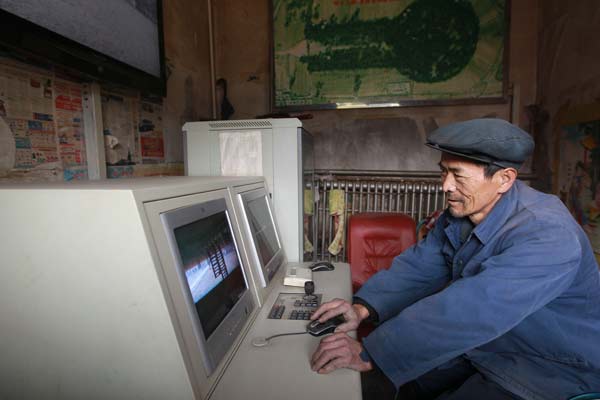Guarding the legacy of emperors
Updated: 2013-04-04 01:50
By WANG XIAODONG (China Daily)
|
||||||||
|
 |
|
Qi Zhenxiang, a keeper of the Yongling mausoleums, can watch the site on a computer. Cui Meng / China Daily |
A complete anti-theft system has been installed in the Royal Mausoleum of Ming, the 80-square-kilometer cemetery of the 13 emperors of the Ming Dynasty and a World Heritage site, according to the Ming Tombs Special Administration in Beijing. Other equipment that has been widely adopted at the site — located 50 km outside Beijing — such as cameras, has also greatly reduced the burden of tomb keepers like Li.
In Yongling Mausoleum alone, 11 cameras have been installed since 2006, at every corner and covering the entire area, according to Li.
"Besides checking on site, we can also check the entire mausoleum at our computer screen at the office, so on rainy days we don't have to go out to check so often," Li said.
The simple office for Li's team sits near the gate of the mausoleum and is less than 10 square meters. Inside, three large screens linked to the cameras give a real-time display of key areas, including the interiors of some buildings.
Qi Zhenxiang, a colleague of Li, was on duty sitting in front of a screen.
A single bed lies on the other side of the room, making it a temporary dorm.
"We usually work here and go back to our village to have meal," Li said.
Both Li and Qi live in Yongling village, one named after the mausoleum, which is only 10 minutes' walk away.
"My ancestors came to the village several hundreds years ago during the Qing Dynasty (1644-1911) as tomb keepers," Li said. "I don't know which generation I am."
Like Yongling Mausoleum, every mausoleum of the Royal Mausoleum of Ming is located near a village named after the mausoleum.

 Li Na on Time cover, makes influential 100 list
Li Na on Time cover, makes influential 100 list
 FBI releases photos of 2 Boston bombings suspects
FBI releases photos of 2 Boston bombings suspects
 World's wackiest hairstyles
World's wackiest hairstyles
 Sandstorms strike Northwest China
Sandstorms strike Northwest China
 Never-seen photos of Madonna on display
Never-seen photos of Madonna on display
 H7N9 outbreak linked to waterfowl migration
H7N9 outbreak linked to waterfowl migration
 Dozens feared dead in Texas plant blast
Dozens feared dead in Texas plant blast
 Venezuelan court rules out manual votes counting
Venezuelan court rules out manual votes counting
Most Viewed
Editor's Picks

|

|

|

|

|

|
Today's Top News
Boston bombing suspect reported cornered on boat
7.0-magnitude quake hits Sichuan
Cross-talk artist helps to spread the word
'Green' awareness levels drop in Beijing
Palace Museum spruces up
First couple on Time's list of most influential
H7N9 flu transmission studied
Trading channels 'need to broaden'
US Weekly

|

|







